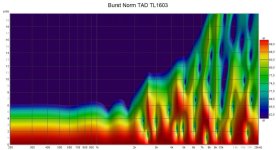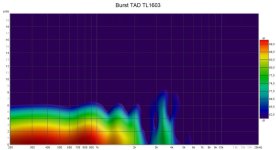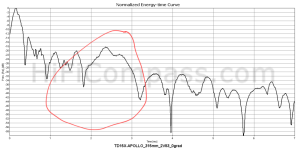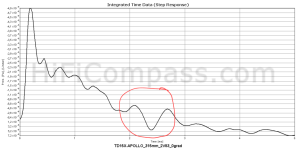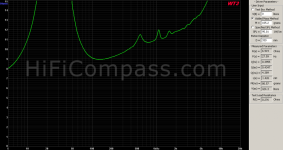As you need less excursion and current than with smaller drivers, the magnet system becomes less critical also. A well made modern standard magnet system, problably with a shorting ring and neo magnet is fully sufficient. But care more for the mechanical losses to ensue that it can reproduce fine detals and sound good also at low listening levels.
So, what is the definition of "End Game"? For me it is the speaker that gives the overall best tradeoff for the application and use case, but not the one with somewhat most exhausted and most expensive driver....
Best regards
Peter
I often look at at Le and mechanical loss... role of Fs is not clear to me if talking of sealed bass system I prefer.
I spent time to look for about butyle vs PA driver with fabric surounds that can have low loss as well (You talked about Faital and indeed their speeder/surround seem to have good spec there...).
But relation withh the F3,F6,F10 numbers according the room gain in a normal building flat is not clear. some can live with a 12" with a 55 hz f3, some not...
I tend to gravitate to higher Vas drivers too. A WAG I can't prove is hysteresis and inertia are more favorable at normal listening levels. IDK if loudspeaker math and measurements address these two factors. Altec, TAD, AE and older JBL all lean toward larger Vas with high regards. However, from what little measurements I've seen on these devices and the measurements I've taken of the TD15S cone resonances could be more of a factor at 400-500hz on larger Vas devices. Furthermore 150-200ltr boxes will have a first resonance around 300hz. Those who design to avoid resonance should stick to crossovers below 300hz.Always read by designers saying such bass drivers gave better sound but the price being bigger cabinets. No life below 400 L VAS and 15" if a standalone bass driver per channel.
For in room use in a sealed config, i use don't use the F3 as reference, but the F6. So where you want a F3 of 30Hz in open air, use an F6 of 30Hz for in rooms use as target. Depending on the driver the F3 will be higher, mostly about 10Hz, but with the slow slope and boundary gain of the room, the bass will be more or less flat down to 30Hz in that room before it goes down (room and placement dependent off course, this is hard to predict). It's a system that worked for me in several occasions and i know many others also use that rule of thump.
That's very usefull inputs ! 🙂
For more clarity as I see elswhere in a recent dev thread where the op is saying he needs a straigth line 2Pi till 30Hz according his previous developments : Do you speak about 2Pi from a sim/datasheet ? Or is it after ahving took the measurement in the room of the bass unit in its enclosure one grossly sized according the Vas of the datasheet ?
So 4pi if for instance the mic is near the enclosure on the soil as the cabinet o the soil (putted on the soin on its side to make the bass unit the closer to the soil). ?
For more clarity as I see elswhere in a recent dev thread where the op is saying he needs a straigth line 2Pi till 30Hz according his previous developments : Do you speak about 2Pi from a sim/datasheet ? Or is it after ahving took the measurement in the room of the bass unit in its enclosure one grossly sized according the Vas of the datasheet ?
So 4pi if for instance the mic is near the enclosure on the soil as the cabinet o the soil (putted on the soin on its side to make the bass unit the closer to the soil). ?
It's surprising to me that SB Acoustics SB34SWPL76-4 is rarely mentioned in discussions such as these.
It is a low sensitivity woofer, but assuming correct T/S parameters, this 12" sub driver needs only a 22.6 liter sealed box for system Q = 0.7 and Fs = 42.6Hz. The tiny required Vb is quite amazing. 15mm Xmax & 300W power means it can produce Max SPL of 101 dB at 25 Hz. A pair, 107 dB.
For a high output high end system, a pair of these drivers series-wired (for 8 ohm load) dual-opposed in a 46 liter closed would be tough to beat. No separate subs needed with DSP/PEQ. A stereo pair would have Max SPL of 113 dB at 25 Hz with 300W per driver. That's easy with class-D amps these days.
In contrast, the more popular SB34SWNRX-S75-6 has lower Xmax (11mm) and requires Vb=43.5 liters to achieve Q=0.7 with slightly less low extension and 2 dB lower Max SPL.
Am I missing something?
----------------
The above data was calculated with WinISD using the driver file from https://loudspeakerdatabase.com/SB/SB34SWPL76-4 & https://loudspeakerdatabase.com/SB/SB34SWNRX-S75-6
I used SBA's 300W and 200W ratings for the SB34SWPL76-4 & SB34SWNRX-S75-6, respectively.
It is a low sensitivity woofer, but assuming correct T/S parameters, this 12" sub driver needs only a 22.6 liter sealed box for system Q = 0.7 and Fs = 42.6Hz. The tiny required Vb is quite amazing. 15mm Xmax & 300W power means it can produce Max SPL of 101 dB at 25 Hz. A pair, 107 dB.
For a high output high end system, a pair of these drivers series-wired (for 8 ohm load) dual-opposed in a 46 liter closed would be tough to beat. No separate subs needed with DSP/PEQ. A stereo pair would have Max SPL of 113 dB at 25 Hz with 300W per driver. That's easy with class-D amps these days.
In contrast, the more popular SB34SWNRX-S75-6 has lower Xmax (11mm) and requires Vb=43.5 liters to achieve Q=0.7 with slightly less low extension and 2 dB lower Max SPL.
Am I missing something?
----------------
The above data was calculated with WinISD using the driver file from https://loudspeakerdatabase.com/SB/SB34SWPL76-4 & https://loudspeakerdatabase.com/SB/SB34SWNRX-S75-6
I used SBA's 300W and 200W ratings for the SB34SWPL76-4 & SB34SWNRX-S75-6, respectively.
Yes, what you have : very high Le, one kilo cone, very low efficienty and just Xmax.... good for sub and infra bass. The problem is not to make the sound but to stop it without ringing till the next note I believe. High Vas, 15 to 16", 100 g, not stelar Le, a little effiienty, something 2.5" voice coil length ( ?)seemed to work fine (Altec, etc).
The sub with low Vas of SB Acoustic (the flats one) are imofor HT and high power active conf.
The sub with low Vas of SB Acoustic (the flats one) are imofor HT and high power active conf.
OK, so why do you think high Le is such a problem?
also, where do you get "one kilo cone"? Moving mass is stated to be 266g, higher than the 154g of the SB34SWNRX-S75-6 but hardly a kilo!
also, where do you get "one kilo cone"? Moving mass is stated to be 266g, higher than the 154g of the SB34SWNRX-S75-6 but hardly a kilo!
my woke is ligther ! Too much inductance seems to be a bad brake. The kilo thing was a hyperbole !
Has little to do with VAS.However, from what little measurements I've seen on these devices and the measurements I've taken of the TD15S cone resonances could be more of a factor at 400-500hz on larger Vas devices.
It is the cone/surround resonance area of a typical 15".
Which has not been adressed in the driver design.
TAD and Fostex Laboratory (W), is about the only ones who does not show it, because of treated cones, damped surround etc.
Also a TAD recone kit is not a circle actually, which also helps.
As for the AE TDxx. They have also got a anomaly in the impulse and ETC curves that should not be there (look at attachments).
Attachments
How is it much more of a brake then a huge inductor put in series to do the exact same thing?Too much inductance seems to be a bad brake.
Unless going active, the result is not all that different.
You just need a heap of passive xo parts to achieve the same as the coil inductance does more or less.
Taming the cone breakups and "pulling" the output down in level.
Not stating in any way that high LE is desireable obviously.
Older drivers made for a passive implementation the choice makes sense as one can get away with simple filters etc.
Yes, Klippel's distortion analysis for drivers point to it being a significant source of distortion in the driver.
But if the circuit it is connected through does the same?
Never touched the 1601A specifically. They do not enjoy a lot of power.Based on your posts, you seem to have experience with this woofer. What would be your enclosure recommendation from let us say 40Hz up for the 1601a?
And be careful with older used ones, they can demag from excessive power as most vintage Alnicos.
The 1601B and 1603 though i have dealt with.
The mfg. recommended enclosure volume, between 132 and 300 liters ported (depending on tuning) is solid.
If you wanna reach 40hz, on the larger side.
Also is dependent on your placement/room/boundary reinforcement etc.
Planet10 has a interesting resistive vent, 'matrix' braced enclosure designed for it too, worth a look.
Personally i have a affinity for closed boxes and plenty of SD, with multiple subs below up to 60/80hz.
Meaning not WAF friendly and requires large total enclosure volume.
Last edited:
The PTT10.0X can compete/outperform a 12” … but can it perform at higher SPL (with same distortion limit) or the same SPL with lower distortion than a 15” (with the equivalent Vd?)I’m surprised nobody mentioned Purifi Ptt10… I know… it’s 10inch not 15, but the specs are insane and seems to work great in a sealed enclosure that you said you like.
I’ve yet to see data that supports this.
@Arez,
I wonder about that Le as well.
Seems perhaps different to put serie external for the low pass vs being in a strong magnétic field ? I have no idea. Maybe just the illustration of a not strong magnet enough or too much voice coil layers when too much high?
I wisch Earl Geddes to be here. I remember he liked the B&C with huge BL and efficienty for the 15". Saw it as a simple commodity (the driverd) then applied some LT to lift.
Patrickbatman here said it was not for small living room iirc.
@tktran303 : I can't forget than higher voice travel is equal to much more heat, then some efficienty loss due to thermal colpression whatever you drive it with an Hypex. You have as well less headrom for dynamic transcient I assume, cause thee cone have to fulfill the dynamic travel more, which goes to very high Xmax. Of course all is about the average volume we listen to ours hifi.
Which come back to the OT : how much is needed (sp and Sd according the room size in my basic understanding as primary sizing a 3 Ways.
If I read Diya I come to think a 4 ways is needed to distribute subwoofs anyway to figth the room modes.
I wonder about that Le as well.
Seems perhaps different to put serie external for the low pass vs being in a strong magnétic field ? I have no idea. Maybe just the illustration of a not strong magnet enough or too much voice coil layers when too much high?
I wisch Earl Geddes to be here. I remember he liked the B&C with huge BL and efficienty for the 15". Saw it as a simple commodity (the driverd) then applied some LT to lift.
Patrickbatman here said it was not for small living room iirc.
@tktran303 : I can't forget than higher voice travel is equal to much more heat, then some efficienty loss due to thermal colpression whatever you drive it with an Hypex. You have as well less headrom for dynamic transcient I assume, cause thee cone have to fulfill the dynamic travel more, which goes to very high Xmax. Of course all is about the average volume we listen to ours hifi.
Which come back to the OT : how much is needed (sp and Sd according the room size in my basic understanding as primary sizing a 3 Ways.
If I read Diya I come to think a 4 ways is needed to distribute subwoofs anyway to figth the room modes.
Last edited:
Depends on the room and your modal range……you don’t want a single driver playing across the modal range into transition zone anyway…..hence the popularity of the subwoofer in a typical size listening space as the shift from modal to transition is around 80hz give or take. Above this, drivers are typically marketed as woofers and from a design perspective optimized for midbass use.
I also prefer sealed boxes. A pair of the above in 100L sealed box cabinets, 13 3/4" (35cm) wide. Note- below is with no EQ applied.
Sensitivity: ~91.7dB/2.83V (Ref 100Hz) /1m (brown line- 4pi)
Anechoic F3/F6/F10 - 43/36/29 (Hz)
Long term maximum SPL: >115dB in half space (black line- 2 pi);
based on IEC rated maximum power (350W), IEC weighted pink noise applied continuously for 100 hours, from 100Hz to 1KHz /1m,
x-max not exceeded.
Maximum short term sine wave output on-axis in half space, averaged from 100 Hz to 1 kHz at 1 m:
122dB
NB. Requires amplifier that can deliver 64V transients. Excursion still within the limits of the voice coil (<x-damage)
Pictures, or it doesn't exist?
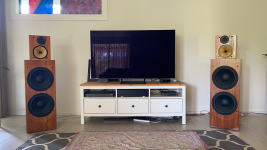
from: https://www.diyaudio.com/community/...and-for-scanspeak-7-2-way.420013/post-7846629
Last edited:
It was desiGned to meet and xceed all specifications of 1238(1” tweeter + 5” midrange)A(+ 15” ported woofer) and AC (twin 10” ported woofers).
Another option of twin 12" woofers wired for 8 ohm nominal load:
Twin 12" alu cone XXLS P-835017 (4 ohm) wired in series
Sealed box, this time smaller volume 70L:
Sensitivity: 89dB/2.83V
F3/F6/F10: 53/41/31Hz

Long term maximum SPL: 116dB in half space (black line- 2 pi);
based on IEC rated maximum power (240W), IEC weighted pink noise applied continuously for 100 hours, from 100Hz to 1KHz /1m,
x-max not exceeded.

Maximum short term sine wave output on-axis in half space, averaged from 100 Hz to 1 kHz at 1 m: 122dB
NB. Requires amplifier that can deliver 89.4V transients (1kW into 8 ohms)

Although not extending as deep, in a 100L sealed enclosure, has more than 4dB higher maximum SPL above 100Hz than a pair of 12” woofers with equivalent excursion.
Sensitivity: 92dB/2.83V (Ref 100Hz) /1m (brown line- 4pi)
Anechoic F3/F6/F10 - 64/48/35 (Hz)

Long term maximum SPL: >120dB in half space (black line- 2 pi); from 100Hz to 1KHz /1m; x-max not exceeded.

Here's it is with 89.4V applied, which is 1000W (8 ohms), close to 1200W AES noise power handling rating (applied continuously for 2 hours)

Here's BMS' own measurement:

Reference:
https://www.bmsspeakers.com/index.php-184.html?id=15n850v2_curves
Another option of twin 12" woofers wired for 8 ohm nominal load:
Twin 12" alu cone XXLS P-835017 (4 ohm) wired in series
Sealed box, this time smaller volume 70L:
Sensitivity: 89dB/2.83V
F3/F6/F10: 53/41/31Hz
Long term maximum SPL: 116dB in half space (black line- 2 pi);
based on IEC rated maximum power (240W), IEC weighted pink noise applied continuously for 100 hours, from 100Hz to 1KHz /1m,
x-max not exceeded.
Maximum short term sine wave output on-axis in half space, averaged from 100 Hz to 1 kHz at 1 m: 122dB
NB. Requires amplifier that can deliver 89.4V transients (1kW into 8 ohms)
Now I understand why:I don’t know why people recommend BMS…
Although not extending as deep, in a 100L sealed enclosure, has more than 4dB higher maximum SPL above 100Hz than a pair of 12” woofers with equivalent excursion.
Sensitivity: 92dB/2.83V (Ref 100Hz) /1m (brown line- 4pi)
Anechoic F3/F6/F10 - 64/48/35 (Hz)
Long term maximum SPL: >120dB in half space (black line- 2 pi); from 100Hz to 1KHz /1m; x-max not exceeded.
Here's it is with 89.4V applied, which is 1000W (8 ohms), close to 1200W AES noise power handling rating (applied continuously for 2 hours)
Max SPL for 100+ Hz: 126dB. Note: x-max EXCEEDED.
Here's BMS' own measurement:
Reference:
https://www.bmsspeakers.com/index.php-184.html?id=15n850v2_curves
Last edited:
- Home
- Loudspeakers
- Multi-Way
- 15" Woofer suggestions for End-Game 3-Way?
